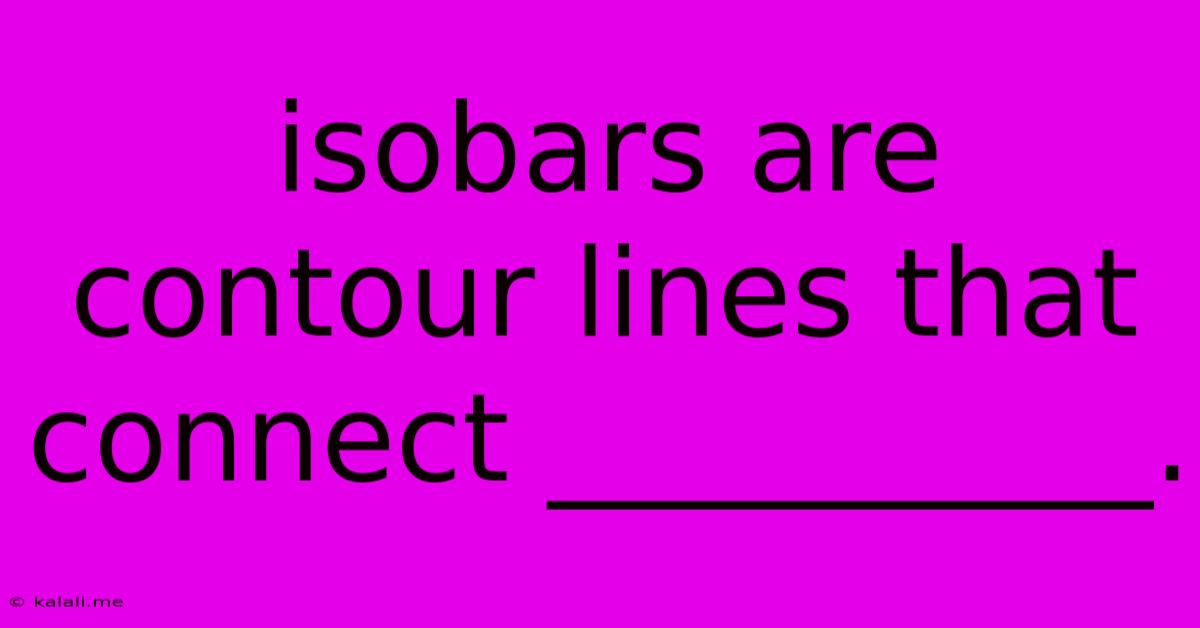Isobars Are Contour Lines That Connect __________.
Kalali
Jun 14, 2025 · 3 min read

Table of Contents
Isobars Are Contour Lines That Connect Points of Equal Pressure
Isobars are a crucial tool in meteorology and weather forecasting, providing a visual representation of atmospheric pressure across a geographical area. Understanding what they connect is key to interpreting weather maps and predicting weather patterns. This article will delve into the definition of isobars, their significance, and how they are used to understand weather systems.
What are Isobars?
Isobars are contour lines drawn on a weather map that connect points of equal atmospheric pressure at a given time. These lines are typically drawn at intervals of 4 or 8 millibars (mb) or hectopascals (hPa), representing a consistent pressure level across the map. The closer the isobars are to one another, the steeper the pressure gradient, indicating stronger winds. Conversely, widely spaced isobars suggest a weaker pressure gradient and lighter winds.
Significance of Isobars in Meteorology
Isobars are indispensable in meteorology for several reasons:
-
Identifying Pressure Systems: Isobars help identify high-pressure (anticyclones) and low-pressure (cyclones) systems. High-pressure systems are characterized by closed isobars with pressure increasing towards the center, while low-pressure systems have closed isobars with pressure decreasing towards the center. These systems are fundamental in shaping weather patterns.
-
Predicting Wind Speed and Direction: The spacing of isobars directly relates to wind speed. Closely packed isobars indicate a steep pressure gradient, resulting in stronger winds. The direction of wind is generally perpendicular to the isobars, flowing from high pressure to low pressure. This is known as the pressure gradient force. Understanding this relationship helps predict wind conditions.
-
Forecasting Weather: The movement and evolution of isobar patterns are essential in weather forecasting. By tracking changes in isobar configurations, meteorologists can predict the development of storms, fronts, and other weather phenomena. Analyzing isobar maps over time provides insights into the dynamics of weather systems.
-
Understanding Weather Phenomena: Isobars help visualize various weather phenomena, including fronts (boundaries between air masses of different temperatures and pressures), troughs (elongated areas of low pressure), and ridges (elongated areas of high pressure). These features are crucial for understanding the complex interplay of atmospheric forces.
Interpreting Isobar Maps:
Interpreting isobar maps requires understanding the following key aspects:
-
Pressure Values: The numerical values associated with each isobar indicate the atmospheric pressure in millibars or hectopascals.
-
Isobar Spacing: The closer the isobars, the stronger the winds.
-
Closed Systems: Closed isobars indicate high-pressure or low-pressure systems.
-
Open Systems: Open isobars represent troughs and ridges.
-
Wind Direction: Wind flows generally perpendicular to the isobars, from high pressure to low pressure.
Conclusion:
In summary, isobars are contour lines that connect points of equal atmospheric pressure on a weather map. They are a fundamental tool in meteorology for identifying pressure systems, predicting wind, forecasting weather, and understanding various atmospheric phenomena. The ability to interpret isobar maps is crucial for anyone involved in meteorology or weather forecasting. Understanding the spacing and configuration of isobars allows for a more accurate prediction of future weather conditions and potential weather hazards.
Latest Posts
Latest Posts
-
Find The Area Of A Circle With Radius 28 Cm
Jun 15, 2025
-
Which Statement Is True About Ftp
Jun 15, 2025
-
How To Find The Largest Fraction
Jun 15, 2025
-
How Many Naturally Occurring Elements Are On Earth
Jun 15, 2025
-
What Is The Most Important Factor In Successful Learning
Jun 15, 2025
Related Post
Thank you for visiting our website which covers about Isobars Are Contour Lines That Connect __________. . We hope the information provided has been useful to you. Feel free to contact us if you have any questions or need further assistance. See you next time and don't miss to bookmark.